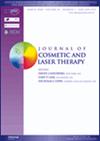离体模型静脉内激光消融对静脉壁破坏的分析
IF 1.3
4区 医学
Q3 DERMATOLOGY
引用次数: 0
摘要
摘要:本研究旨在建立离体静脉内激光消融(EVLA)实验模型,并评估使用差示扫描量热法(DSC)测定静脉组织胶原变性程度和优化激光治疗设置的可能性。对照(非曲张)和曲张静脉标本进行化学、热和形态学分析。用1.56 μm和0.97 μm激光照射曲张静脉碎片,照射条件与临床EVLA手术非常相似。激光处理后的标本进行了热分析和组织学分析。在对照组和曲张静脉之间检测到化学成分和结构的显著差异。静脉曲张后,糖胺聚糖含量显著升高(P = 0.02),弹性蛋白含量降低不显著(P = 0.26),胶原含量略有升高,但不显著(P = 0.14)。静脉曲张表现为壁厚的区域变异性,平滑肌细胞数量减少,胶原纤维变薄、松动和纤维化。临界激光辐射功率同时导致胶原完全变性(如DSC数据所示)和所有三静脉壁层凝固坏死,组织完全均匀化和血管闭塞(如组织学分析数据所示)。较低的激光辐射功率不能产生这些效果。临界激光功率提供了体外静脉热效应的预期结果,即组织坏死和血管破坏。DSC记录的胶原蛋白完全降解可以作为腔内热处理模型中静脉壁不可逆破坏的标志。本文章由计算机程序翻译,如有差异,请以英文原文为准。
Analysis of the vein wall destruction under endovenous laser ablation in an ex vivo model
ABSTRACT This work was aimed at elaborating an experimental ex vivo endovenous laser ablation (EVLA) model and evaluating the possibility of using differential scanning calorimetry (DSC) to determine the degree of collagen denaturation of the venous tissue and optimize the laser treatment settings. The control (non-varicose) and varicose vein specimens were subjected to chemical, thermal and morphological analyses. Varicose vein fragments were irradiated with 1.56-μm and 0.97-μm lasers in conditions closely similar to those of the clinical EVLA procedure. The laser treated specimens were subjected to thermal and histological analyses. A noticeable difference in chemical composition and structure was detected between the control and varicose veins. Glycosaminoglycan content increased significantly in varicose vein (P = .02), elastin content decreased insignificantly (P = .26) while collagen content showed a slight, but not significant, increase (P = .14). Varicose vein demonstrated regional variability in wall thickness, some decrease in the amount of smooth muscle cells, thinning and loosening of collagen fibers and fibrosis. The critical laser radiation power was demonstrated simultaneously to cause complete denaturation of collagen (as indicated by the DSC data) and coagulation necrosis of all the three venous wall layers, total homogenization of the tissue and obliteration of vasa vasorum (as indicated by the histological analysis data). Lower laser radiation powers fail to produce these effects. Critical laser power provides the desired result of the thermal effect on the vein ex vivo, namely, tissue necrosis and vasa vasorum destruction. The complete degradation of the collagen recorded by DSC could be a marker of the irreversible destruction of the vein wall in modeling of endoluminal thermal treatment.
求助全文
通过发布文献求助,成功后即可免费获取论文全文。
去求助
来源期刊

Journal of Cosmetic and Laser Therapy
DERMATOLOGY-SURGERY
CiteScore
2.50
自引率
0.00%
发文量
36
审稿时长
>12 weeks
期刊介绍:
A unique journal that focuses on the application of cosmetic laser and light therapies on the skin. The Journal of Cosmetic & Laser Therapy provides a forum for stimulating and up-to-date studies demonstrating the wide range of therapeutic options for clinicians and surgeons involved in cosmetic and dermatological treatment.
The journal is aimed at dermatologists, cosmetic surgeons, plastic and facial plastic surgeons, oculoplastic surgeons and all those interested in the rapidly expanding field of cosmetic and laser therapy.
Features include:
-Cosmetic surgery, including facial rejuvenation, hair removal and skin resurfacing
-Use of lasers and other light sources for cosmetic and dermatological treatment
-Applications of peeling agents, fillers, injectables, implants and other cosmetic modalities
-Topical treatments
-Practical tips and safety issues
 求助内容:
求助内容: 应助结果提醒方式:
应助结果提醒方式:


